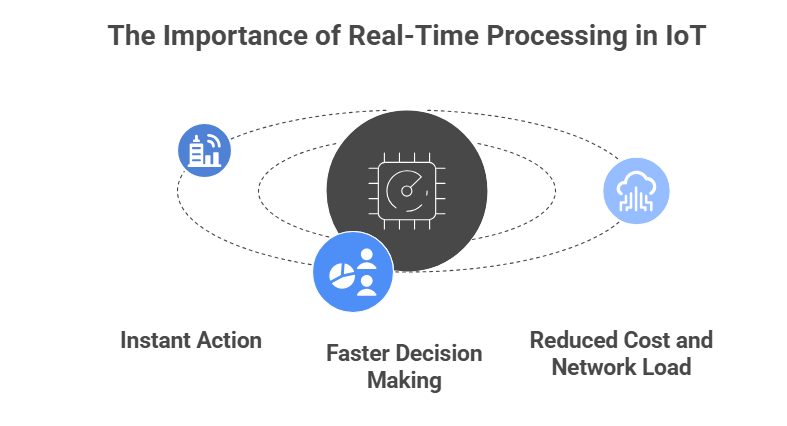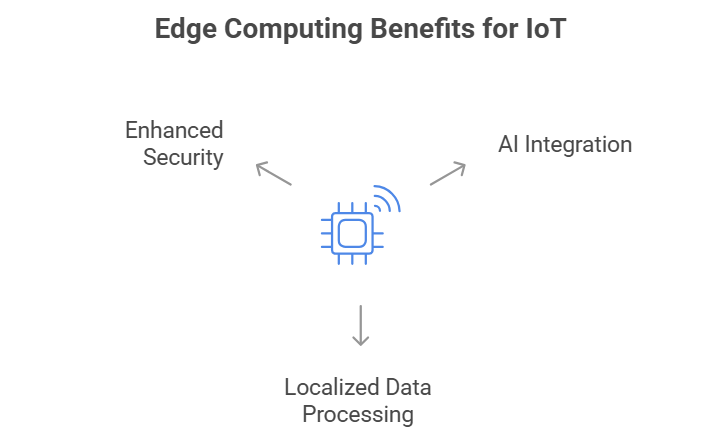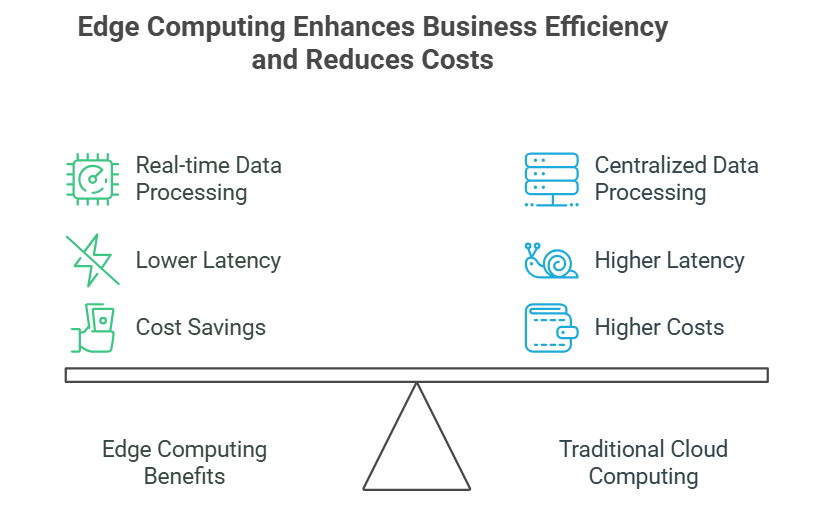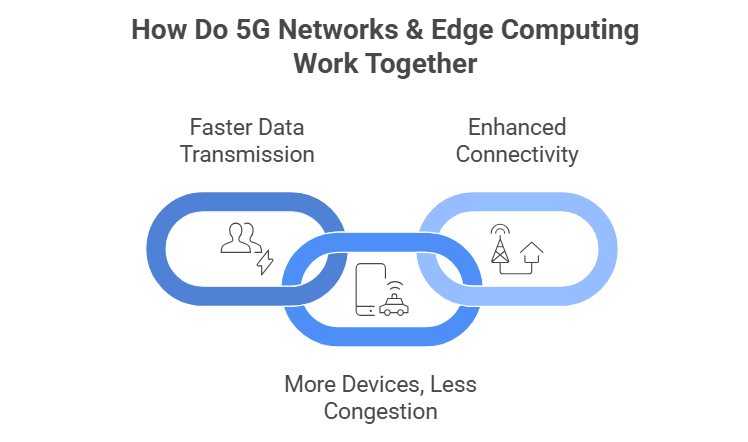How Edge Computing Transforms IoT App Performance
There’s something big happening in the world of IoT. As businesses increasingly rely on connected devices to streamline operations, the need for faster, more efficient data processing is becoming more critical. While cloud computing has traditionally been the go-to for IoT systems, edge computing is quickly becoming a game-changer.
Edge computing allows data to be processed closer to where it’s generated, rather than depending solely on centralized cloud servers. This shift is making IoT apps faster, reducing latency, and enabling real-time processing in ways that just weren’t possible before.
But how does this technology actually work, and what does it mean for IoT app development company is looking to enhance their solutions? In this blog, we’ll dive into how edge computing boosts IoT app performance, its impact on industries using smart IoT technologies, and the latest trends in IoT that are changing the way data is processed and handled.
Key Takeaways for IoT App Developers
- Edge computing enables real-time data processing and reduces latency in IoT systems, making devices smarter and more responsive.
- By processing data locally, edge computing reduces the need to transmit large volumes of data to centralized servers, improving efficiency and bandwidth.
- IoT app performance can be significantly enhanced by integrating edge computing, making IoT systems faster, more reliable, and capable of processing data in real time.
- Emerging technologies like 5G networks and AI are accelerating the adoption of edge computing in IoT systems, allowing for smarter devices and more advanced IoT solutions.
What Is Edge Computing and Why Does It Matter for IoT?
Edge computing involves processing data closer to where it’s generated at the “edge” of the network rather than sending all the data to centralized cloud servers.
But why is this important?
The answer lies in the speed and efficiency that local processing brings. In IoT systems, data is continuously generated by various sensors, devices, and applications. Without edge computing, this data has to travel a long distance to the cloud for processing. This delays decision-making and increases latency.
How Does Edge Computing Reduce Latency?
Latency is one of the most significant issues in IoT applications, particularly for real-time data processing. But how does edge computing combat latency?
Instead of sending all the data to the cloud for processing and waiting for a response, edge computing processes the data right at the point of origin. This local processing cuts down the distance data needs to travel, allowing for quicker data handling and lower latency.
Consider the difference it can make for an industrial IoT system that needs to respond to changing conditions in real time. With cloud computing, there can be a delay as data travels to the cloud and back. With edge computing, the data is processed locally, and decisions can be made on the spot, enabling a more efficient system with minimal delay.
Why is Real-Time Processing So Important for IoT Applications?

For many IoT applications, especially those involved in automation or real-time decision-making, real-time processing is essential.
IoT devices generate massive amounts of data continuously. If you wait for that data to be sent to the cloud for processing, you risk losing valuable time. By processing that data locally, edge computing enables faster insights that are critical for IoT applications to respond instantly.
- Instant Action: In applications like smart cities or healthcare, being able to process and act on data instantly can improve both user experience and outcomes.
- Faster Decision Making: With real-time data, businesses can respond faster to customer needs or environmental changes, giving them a competitive edge.
- Reduced Cost and Network Load: Local data processing reduces the need for constant cloud communication, saving on bandwidth and infrastructure costs.
How Does Edge Computing Enhance Smart IoT Solutions?

One of the most exciting things about edge computing is its ability to create smarter IoT solutions. But how does it do this?
Edge computing allows devices and sensors to analyze and respond to data right at the source. This empowers IoT systems to become more intelligent, adaptive, and efficient. Here are some key ways edge computing supports smart IoT solutions:
- AI Integration: Many IoT devices are now equipped with AI capabilities. With edge computing, AI algorithms can run locally on the device, enabling the system to learn from data and make smarter decisions in real time.
- Localized Data Processing: Edge computing reduces reliance on cloud-based processing and makes IoT systems more self-sufficient. Devices can make decisions and adapt based on data from their surroundings, improving functionality.
- Enhanced Security: Because data is processed locally and not continuously sent to the cloud, there’s less risk of sensitive information being exposed to the internet. This is especially important for industries like healthcare and manufacturing, where security and privacy are paramount.
Can Edge Computing Improve Business Operations?

Edge computing isn’t just about improving IoT app performance it also brings tangible benefits for business operations. So, how does it help businesses?
- Increased Efficiency: With real-time data processing and reduced reliance on cloud systems, edge computing streamlines operations, especially in environments like factories, logistics, and remote monitoring.
- Lower Latency for Better Service: Businesses that rely on IoT for customer-facing applications, such as smart retail or on-demand services, benefit from edge computing’s ability to deliver quick responses to customer requests.
- Cost Savings: With local processing, businesses can save on bandwidth and cloud infrastructure costs. This makes edge computing not only a performance booster but also a cost-effective solution.
The ability to process data locally and make faster decisions means that businesses can operate more efficiently, providing better services and gaining a competitive advantage.
How Do 5G Networks and Edge Computing Work Together?

5G networks and edge computing are a powerful combination for boosting IoT app performance. Why?
- Faster Data Transmission: 5G’s ultra-low latency and high speeds work hand-in-hand with edge computing, ensuring that IoT devices can send data faster and receive insights in real time.
- More Devices, Less Congestion: 5G networks support a massive number of connected devices, which is ideal for IoT systems that rely on numerous sensors and devices working simultaneously.
- Enhanced Connectivity: 5G’s reliable, high-speed connectivity helps IoT applications that require constant data transfer, especially when working with edge-computed data.
Together, 5G and edge computing will create a new generation of IoT apps that are faster, smarter, and more efficient.
Why Partner with App Maisters for Your Edge-Enabled IoT Solutions?
Edge computing is rapidly transforming the way IoT applications perform. By enabling real-time data processing, reducing latency, and providing smarter IoT solutions, edge computing is unlocking new possibilities for industries across the board.
As the technology continues to evolve, businesses will need expert guidance to implement edge computing effectively. At App Maisters, we specialize in developing cutting-edge IoT applications that integrate edge computing for maximum performance and efficiency. Whether you’re looking to optimize real-time processing for healthcare devices, enhance smart city technologies, or improve your industrial IoT systems, our team is here to help.
Reach out to App Maisters today to learn how we can help you take full advantage of the transformative potential of edge computing in your IoT applications.
FAQs
What is edge computing in IoT?
Edge computing processes data locally, near the source, reducing latency and enabling real-time decision-making. App Maisters helps integrate this tech for faster, more efficient IoT apps.
How does edge computing reduce latency in IoT?
By processing data at the edge, edge computing cuts down the time it takes for data to travel, ensuring faster responses. App Maisters leverages this for quick, real-time IoT solutions.
Why is real-time data processing important for IoT?
Real-time processing enables instant decision-making, crucial for smart cities, healthcare, and other IoT apps. App Maisters integrates edge computing to deliver fast, responsive systems.
Can edge computing make IoT devices smarter?
Yes, edge computing enables IoT devices to analyze data and make decisions instantly, making them smarter and more efficient. App Maisters ensures your IoT solutions are powered by edge tech.
How do 5G networks and edge computing improve IoT?
5G’s speed and low latency, combined with edge computing, boost IoT performance by enabling faster data transfer and more devices. App Maisters optimizes this synergy for seamless IoT experiences.
Which industries benefit from edge computing in IoT?
Healthcare, manufacturing, logistics, and smart cities all benefit from faster, cost-efficient IoT solutions. App Maisters delivers edge computing-powered IoT apps for these industries.




















